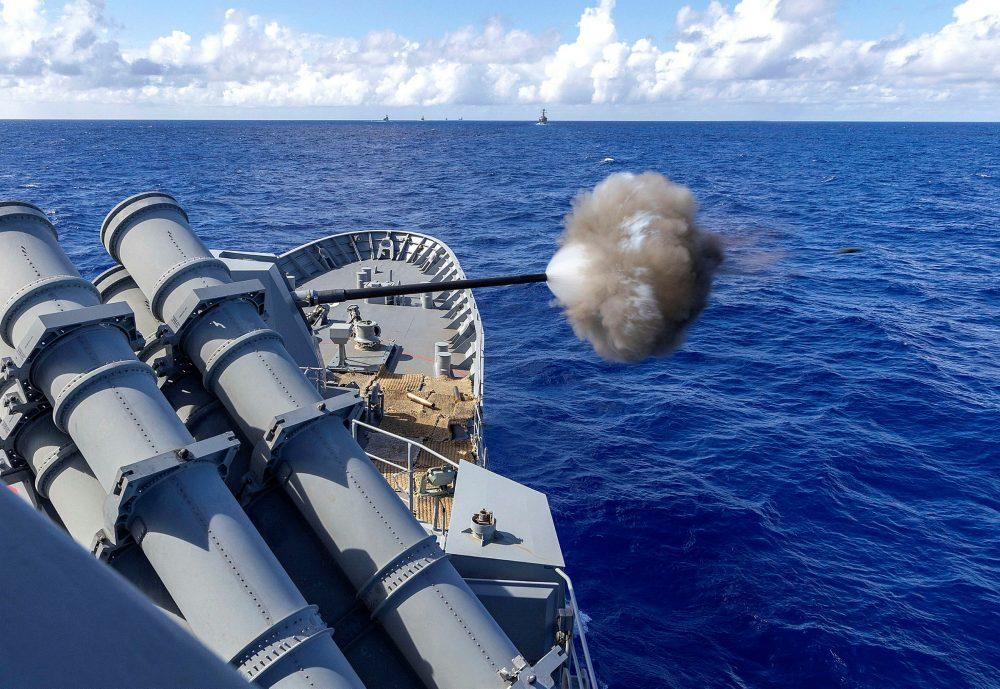
Sea state
The Royal Australian Navy has just wrapped up two significant multi-navy drills. Anzac-class frigate HMAS Ballarat and oil tanker HMAS Sirius joined in on phase 2 of Exercise Malabar 2021 with India, Japan and the United States in the Bay of Bengal. The first phase was held off Guam in August and marked the second consecutive year of Australia’s participation in Malabar. The exercises aim to improve interoperability and navy-to-navy ties between the Quad member nations.
HMA Ships Canberra and Anzac participated in Bersama Gold 21 alongside the other navies in the Five Power Defence Arrangements—Britain, Malaysia, New Zealand and Singapore. The exercise coincided with the 50th anniversary of the FPDA and incorporated maritime and air scenarios and virtual seminars.
Meanwhile, Russia and China conducted coordinated drills in the Sea of Japan. Joint Sea 21 incorporated anti-submarine and anti-mine manoeuvres, air operations and target practice. The drills (see video) involved submarines and planes from both navies, as well as destroyers, corvettes, minesweepers and supply vessels.
Flight path
Last Wednesday, a Royal Australian Navy MH-60R Seahawk helicopter was forced to make an emergency landing in the Philippine Sea. The three crew members onboard sustained minor injuries and were rescued by boats from the nearby HMAS Brisbane. The RAN initially paused operation of its 24 MH-60Rs, but has since lifted flight restrictions after concluding that the incident wasn’t a fleet-wide issue. The US recently approved the proposed sale of 12 additional MH-60R helicopters to Australia for $1.3 billion, to replace the troubled MRH-90 Taipan in naval service.
Satellite imagery analysis shows that China is making major upgrades to three air bases in the country’s east—Longtian, Huian and Zhangzhou—all within 160 to 320 kilometres of Taiwan. Construction works include protective bomb-shelter aviation infrastructure, storage bunkers, barracks and administrative buildings—improvements that could support greater operational capacity and conceal military assets. In an environment of escalating cross-strait tensions and Chinese flyovers, analysts suggest these new facilities will allow increased intimidation of Taipei.
Rapid fire
The US Army has significantly delayed its much publicised US$22 billion contract with Microsoft for an ‘integrated visual augmentation system’. The project involves the development of augmented-reality headsets to provide soldiers on the battlefield with ‘waypoints and other navigation symbology’ similar to those used by combat pilots. While the army says it ‘remains committed’ to the project, early versions didn’t function in the rain and the potential for batteries to be damaged in combat raised safety concerns.
On Monday, Rheinmetall Defence Australia unveiled its new Lynx combat support vehicle, which is touted as the ‘most sophisticated’ armoured vehicle ever designed and built in Australia. Similar to a version being built for the Hungarian Army, the Lynx CSV was designed as a ‘uniquely Australian workhorse [with] the distinct function of a ute’. Containing extra fuel capacity and a crane capable of lifting more than five tonnes, the Lynx is envisaged as providing recovery, repair and logistics support functions to vehicles on the battlefield.
Final frontier
The Australian Space Agency will provide a rover from Australia’s Trailblazer program for a lunar landing mission with NASA. The rover, which will incorporate Australian expertise in mining and robotics, will weigh up to 30 kilograms and retrieve lunar regolith to be analysed in NASA’s lander. Australia has committed more than $150 million to its Moon to Mars initiative since entering a lunar exploration agreement with NASA in 2019. ASA says the rover may play a role in setting up outposts on the moon and facilitating human exploration on Mars.
China’s Shenzhou 13 spacecraft has docked at Tiangong space station and its three Chinese astronauts are commencing a six-month stay that’s set to be China’s longest. Before the mission, China renewed its vow to promote peaceful international cooperation in space. However, this commitment was cast into doubt by reports that the People’s Liberation Army used space capabilities when testing a nuclear-capable hypersonic missile in August. China says the event was actually a routine spacecraft check.
Wired watchtower
Cybersecurity experts have criticised plans devised by Apple and the European Union to scan iPhones for child sexual abuse material, regarding it as ‘dangerous technology’. The proposal would allow Apple to review images uploaded to its iCloud service and notify parents when their child sent or received nude imagery in text messages. In a Cornell University study, researchers said, ‘It should be a national-security priority to resist attempts to spy on and influence law-abiding citizens.’ Researchers also noted that this technology would likely be ineffective at identifying child sexual material.
The US Treasury has pinpointed approximately US$5.2 billion in Bitcoin transactions potentially tied to ransomware attacks between 2011 and 2021. The analysis comes after President Joe Biden’s administration committed to cracking down on ransomware attacks by shutting down digital payment systems that had been enabling criminal activity to thrive. The Treasury has also told the cryptocurrency industry that it must ensure it does not assist in making deals that are contrary to US sanctions.